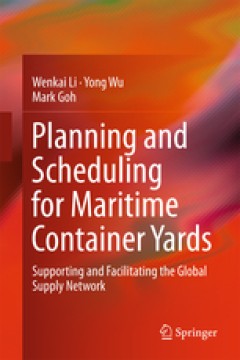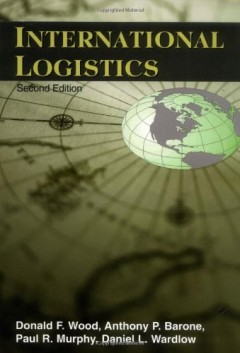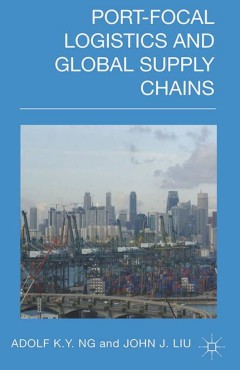Ditapis dengan

Being global : how to think, act, and lead in a transformed world
What makes being a global business leader today such a complex task? It’s more than mastering your knowledge of various geographies and cultures, though that is essential. But to succeed, you must also master the complex mind-set and competencies needed to lead in today’s fully globalized world. Not an easy assignment.Enter Ángel Cabrera and Gregory Unruh. In Being Global, they pull from …
- Edisi
- -
- ISBN/ISSN
- 978-1-4221-8322-9
- Deskripsi Fisik
- 206 p, 25 cm ; index
- Judul Seri
- -
- No. Panggil
- LC 658.409 CAB b

Review Of Maritime Transport 2014
Global economic growth faltered in 2013 as economic activity in developing regions suffered setbacks and as the situation in the advanced economies improved only slightly. Prospects for the world economy, trade and shipping seem to be improving although a number of risks mostly on the downside remain.
- Edisi
- -
- ISBN/ISSN
- 978-92-1-112878-9
- Deskripsi Fisik
- xiii, 118 p., : illus: table : 30 cm
- Judul Seri
- -
- No. Panggil
- REF MR UNC r

Time Charters
This book describe about the case law in time charters in a way which will help those engaged in chartering and operating ships to refer to the leading authorities on any particular point of doubt as quickly and easily as possible. The contents of the book is formation of the contract, parties to the contract, description of the ship, terms of the contract, remedies for breach of contract, wai…
- Edisi
- 2
- ISBN/ISSN
- 0-907432-13-1
- Deskripsi Fisik
- lxix, 505 p., : illus : index : 25 cm
- Judul Seri
- -
- No. Panggil
- TXT PO WIL t

International Trade
Assuming a minimum exposure to Principles of Microeconomics, this book reviews economic models and presents theories to explain the benefits and goals of trade between countries. It is rigorous and unique in its presentation of stories about countries in today's world. In addition to real-world stories, the text also offers standard theoretical constructs and economic models.
- Edisi
- -
- ISBN/ISSN
- 978-0470408797
- Deskripsi Fisik
- xxi, 329p. ; 26cm.
- Judul Seri
- -
- No. Panggil
- MR MCL i

Integrating seaports and trade corridors
- Edisi
- first edition
- ISBN/ISSN
- -
- Deskripsi Fisik
- 4 p .
- Judul Seri
- -
- No. Panggil
- ARC PO HAL i
- Edisi
- first edition
- ISBN/ISSN
- -
- Deskripsi Fisik
- 4 p .
- Judul Seri
- -
- No. Panggil
- ARC PO HAL i

Fundamental trade union rights and european constitution
“The new Eu ro pean Con sti tu tion re cog nises the func tion of the role of the so cial di a logue in the EU con text as a key el e ment of the Eu ro pean strat e gies. But the im pres sion is that the le gal out come con tained in the too so ber sen tences of the Eu ro pean Con sti tu tion is not co her ent with the role gained de facto by so cial part ners to day in the na tional mem bers…
- Edisi
- Volume 47 Number 6 2005
- ISBN/ISSN
- -
- Deskripsi Fisik
- 24 p.
- Judul Seri
- Managerial Law
- No. Panggil
- ATC MR VEN f

Estimating trade-off among logistics cost, CO2 and time: A case study of cont…
One of the basic necessary conditions for successful implementation of policies which encourage the use of intermodal freight transportation systems is to understand ‘‘what the desired mode share of the intermodal freight transportation systems is’’ and also ‘‘what the trade-off relationships among various concerns such as logistics cost, time and CO2 emissions are’’. The object…
- Edisi
- Vol. 16, No. 1, March 2012, 85–98
- ISBN/ISSN
- 2161-6779
- Deskripsi Fisik
- 16 p.
- Judul Seri
- International Journal of Urban Sciences
- No. Panggil
- ATC LO PAR e

Maritime Logistics and Supply Chain Security
Despite a hangover from the worldwide economic crisis, international trade rebounded nicely with a record-level growth in late 2010. A sharp rise in international trade has sparked the international traffic growth. A majority of this traffic growth originated from maritime logistics which could move cargoes in large volume and at cheaper freight costs. Due to its cost-efficiency and easy acces…
- Edisi
- 2012
- ISBN/ISSN
- 978-1-78052-340-8
- Deskripsi Fisik
- 27 P
- Judul Seri
- Maritime Logistics
- No. Panggil
- ATC LO MIN m

the Changing nature of the world bulk trades
- Edisi
- IJPD 6, 1
- ISBN/ISSN
- -
- Deskripsi Fisik
- 7 p.
- Judul Seri
- Communications Forum
- No. Panggil
- ACT MG KIN c
- Edisi
- IJPD 6, 1
- ISBN/ISSN
- -
- Deskripsi Fisik
- 7 p.
- Judul Seri
- Communications Forum
- No. Panggil
- ACT MG KIN c

Planning and scheduling for maritime container yards
- Edisi
- -
- ISBN/ISSN
- 978-3-319-17025-1
- Deskripsi Fisik
- ix, 110 p.
- Judul Seri
- -
- No. Panggil
- TXT MR WEN p
- Edisi
- -
- ISBN/ISSN
- 978-3-319-17025-1
- Deskripsi Fisik
- ix, 110 p.
- Judul Seri
- -
- No. Panggil
- TXT MR WEN p

International logistics
- Edisi
- -
- ISBN/ISSN
- 978-1-4615-2085-6
- Deskripsi Fisik
- -
- Judul Seri
- -
- No. Panggil
- TXT LO Woo i
- Edisi
- -
- ISBN/ISSN
- 978-1-4615-2085-6
- Deskripsi Fisik
- -
- Judul Seri
- -
- No. Panggil
- TXT LO Woo i
Strengthening asem's regions seaport connectivity
- Edisi
- Case: Indonesia Port Bali, 27 September 2017
- ISBN/ISSN
- -
- Deskripsi Fisik
- 35 Page
- Judul Seri
- -
- No. Panggil
- PPT PO ELV s
- Edisi
- Case: Indonesia Port Bali, 27 September 2017
- ISBN/ISSN
- -
- Deskripsi Fisik
- 35 Page
- Judul Seri
- -
- No. Panggil
- PPT PO ELV s

Supply chain typology for configuring cost-efficient tracking in fashion logi…
The purpose of this paper is to propose a typology of radio frequency identification (RFID)-based tracking solution designs to fit differing fashion supply chains. The typology is presented as principles of form and function contributing toward a design theory of configurable RFID tracking for fashion logistics.
- Edisi
- Vol. 26 No. 1, 2015
- ISBN/ISSN
- -
- Deskripsi Fisik
- 21 p.
- Judul Seri
- The International Journal of Logistics Management
- No. Panggil
- ATC LO HOL s

Comparison of trade facilitation at four International ports in Thailand
…
- Edisi
- -
- ISBN/ISSN
- -
- Deskripsi Fisik
- 7 p.
- Judul Seri
- -
- No. Panggil
- ATC PO RUD c

Internationalising industrial disputes : the case of the maritime union of Au…
The purpose of this paper is to examine the capacity for trade unions to mobilise internationally by considering how stevedores in Australia successfully internationalised a major dispute.
- Edisi
- -
- ISBN/ISSN
- -
- Deskripsi Fisik
- 18 p.
- Judul Seri
- -
- No. Panggil
- ATC MR SMI i

Port efficiency and trade flows
Growing international trade and increasing congestion focus attention on trade facilitation. Ocean ports are a central and necessary component in facilitating trade. Yet, there is only limited comprehensive information available on the efficiency of ports, much less evidence of the effect of port efficiency on trade. We develop and apply a straightforward approach to estimate port efficiency. T…
- Edisi
- -
- ISBN/ISSN
- -
- Deskripsi Fisik
- 31 p.
- Judul Seri
- -
- No. Panggil
- ATC PO WIL p

An evaluation of free trade port zone in taiwan
This study focused on the development of FTPZs in Taiwan and examined factors influencing business activities in FTPZs and their degree of importance for improving the operational environment in FTPZs. A performance assessment of companies since operating their businesses in FTPZs was also undertaken. Data for the study were obtained from a questionnaire survey distributed to MNCs operating in …
- Edisi
- Volume 27
- ISBN/ISSN
- -
- Deskripsi Fisik
- 24 p.
- Judul Seri
- -
- No. Panggil
- ATC PO CHI a
Port Engineering and Operation
- Edisi
- -
- ISBN/ISSN
- 0 7277 0244 0
- Deskripsi Fisik
- 207 p
- Judul Seri
- -
- No. Panggil
- TXT PO TEL p
- Edisi
- -
- ISBN/ISSN
- 0 7277 0244 0
- Deskripsi Fisik
- 207 p
- Judul Seri
- -
- No. Panggil
- TXT PO TEL p

Port-Focal Logistics and Global Supply Chains
This book explores the intersection of two trends in the port sector that have occupied researchers in recent years: the port's progressively interventionist role in the hinterland and its increasing importance as a node within supply chains. These trends are set against the backdrop of fierce port competition as the increasing size of modern container vessels drives ports to make huge investm…
- Edisi
- -
- ISBN/ISSN
- 978-1-349-44539-4
- Deskripsi Fisik
- -
- Judul Seri
- -
- No. Panggil
- TXT PO ADO p

Managers' Perceptions of NAFTA
Canadian and United states managers identified NAFTA‐related benefits and threats. These factors were related to the managers' overall perceptions of the effect of NAFTA on firm performance. Results indicated that NAFTA's perceived benefits include increased access to the Mexican market and to other Latin American markets, improved customs procedures, and increased effectiveness and efficienc…
- Edisi
- Vol. 8 Issue: 2, pp.33-46
- ISBN/ISSN
- -
- Deskripsi Fisik
- 16 p.
- Judul Seri
- The International Journal of Logistics Management
- No. Panggil
- ATC LO COO m

Integrated supply chain management from the wholesaler’s perspective: Two A…
Documents two case studies conducted in Australian companies from the wholesaling sector. Both companies are importers and wholesalers supplying into the retail sector. The aim of the case studies was to establish to what extent each had adopted and implemented new technologies for the management of supply chain activities. Although both companies have approached implementation of established t…
- Edisi
- Vol. 32 Issue: 2, pp.96-109
- ISBN/ISSN
- -
- Deskripsi Fisik
- 16 p .
- Judul Seri
- International Journal of Physical Distribution & Logistics Management
- No. Panggil
- ATC LO TER i

Preconditions and dynamics of logistics networks in the dutch building industry
Argues that logistics networks in the building industry will develop in relation to transaction-specific investments in new information technologies such as EDI and PDI. This is particularly the case where strategic considerations play a subordinate role and efficiency arguments are stressed. The limitations of the transaction cost approach are also discussed. In the building industry, logistic…
- Edisi
- Volume 4 . Number 3 . 1999 . 145±154
- ISBN/ISSN
- -
- Deskripsi Fisik
- 12 p.
- Judul Seri
- Supply Chain Management: An International Journal
- No. Panggil
- ATC LO VOO p

Logistics development in China
The accession of the People’s Republic of China to the World Trade Organisation should provide greater access to an erstwhile-untapped market. Trade and foreign investments are expected to increase rapidly. Under this setting, an enormous challenge is posed to the logistics industry as it endeavours to meet the increased demands of the market. Based on the secondary data, this paper finds tha…
- Edisi
- Vol. 33 No. 10, 2003
- ISBN/ISSN
- -
- Deskripsi Fisik
- 36 p.
- Judul Seri
- International Journal of Physical Distribution & Logistics Management
- No. Panggil
- ATC LO LIN l

Logistics in Bulgaria: Concepts for New Market Expansion
Examines the current situation for logistics in Bulgaria. Reviews the prospects for applying logistics concepts with respect to the economic environment for privatization and investment. Presents the findings. Concludes with some cautions concerning the issue of transferring logistics knowledge in Bulgaria.
- Edisi
- Vol. 24 Iss 2 pp. 30 - 36
- ISBN/ISSN
- -
- Deskripsi Fisik
- 10 p.
- Judul Seri
- International Journal of Physical Distribution & Logistics Management
- No. Panggil
- ATC LO PUR l

On the diversification of international freight forwarders: A UK perspective
This paper examines the diversification of services and activities by freight forwarders in the UK. Following similar studies conducted in the USA, the paper analyses the trends towards service and revenue diversification that has been observed in this sector.
- Edisi
- Vol. 36 No. 5, 2006 pp. 336-359
- ISBN/ISSN
- -
- Deskripsi Fisik
- 26 p.
- Judul Seri
- International Journal of Physical Distribution & Logistics Management
- No. Panggil
- ATC LO MAR o

Logistics integration in horizontal mergers and acquisitions
In this article, we describe the integration of logistics after Mergers and Acquisitions (M&As) of firms within the same industry and, same industry level (i.e. horizontal M&As). First, we present a review of the literature on M&As and conclude that operational issues, in general, and logistics issues, in particular, have received little attention. In parallel with the literature review, we con…
- Edisi
- Vol. 15 Iss 1 pp. 27 - 42
- ISBN/ISSN
- -
- Deskripsi Fisik
- 18 p.
- Judul Seri
- The International Journal of Logistics Management
- No. Panggil
- ATC LO OJA l

Analysis of factory gate pricing in the UK grocery supply chain
The paper aims to analyse the reasons behind the leadership shown by a case study retailer through the introduction of factory gate pricing (FGP) within the grocery sector. Further, there is an evaluation of the transport management techniques used to support FGP and the operational benefits gained.
- Edisi
- Vol. 35 No. 10, 2007
- ISBN/ISSN
- -
- Deskripsi Fisik
- 16 p .
- Judul Seri
- International Journal of Retail & Distribution Management
- No. Panggil
- ATC LO LAL a

Translating trade and transport facilitation into strategic operations perfor…
Trade and transport facilitation is a challenging area for international logistics and supply chains. A major problem in the area is the lack of a specific framework to support measurement and analyses of performance aspects concerning border-crossing operations. The purpose of this study was to develop a framework for the area comprising strategic performance objectives of operations.
- Edisi
- Vol. 17 Iss 2 pp. 124 - 137
- ISBN/ISSN
- -
- Deskripsi Fisik
- 16 p .
- Judul Seri
- Supply Chain Management: An International Journal
- No. Panggil
- ATC LO BAT t

Order lead‐time of grocery retailers in the UK and Greek markets
The purpose of this paper is to report the results of a comparative study of order lead times for firms operating in the UK and Greek food retail markets with the UK one being regarded at the forefront in terms of logistics efficiency.
- Edisi
- Vol. 14 Issue: 5
- ISBN/ISSN
- -
- Deskripsi Fisik
- 12 p .
- Judul Seri
- Supply Chain Management: An International Journal
- No. Panggil
- ATC LO MAK o

Methods of payment and foreign-exchange risk management among firms in Brunei…
The purpose of this paper is to examine various methods of payment and foreign-exchange risk management among firms involved in either export or import trade only, or both in Brunei Darussalam. The paper also seeks to delineate the relationship(s) between various characteristics of firms such as number of years in business, size, and frequency of imports, and various methods of payment and fore…
- Edisi
- -
- ISBN/ISSN
- -
- Deskripsi Fisik
- 19 p.
- Judul Seri
- -
- No. Panggil
- ATC MG SIR m

Battening down the hatches : how should the maritime industries weather the �…
This paper investigates the major impacts of the financial tsunami on the maritime industries, notably port and shipping. The maritime industries are still reeling from market declines, with stakeholders still attempting to weather the storm as best as they can through various strategies. However, such strategies are not uniform, where significant diversifications have been noted between maj…
- Edisi
- -
- ISBN/ISSN
- -
- Deskripsi Fisik
- 6 p.
- Judul Seri
- Research in Transportation Economics
- No. Panggil
- ATC MR SLA b

Assesing international port operations
- Edisi
- -
- ISBN/ISSN
- -
- Deskripsi Fisik
- 10 p.
- Judul Seri
- -
- No. Panggil
- ATC PO MUR a
- Edisi
- -
- ISBN/ISSN
- -
- Deskripsi Fisik
- 10 p.
- Judul Seri
- -
- No. Panggil
- ATC PO MUR a

Maritime Piracy And The Cost Of World Trade
Purpose – The aim of this study is to determine the nature and extent of the threat of global maritime piracy. The cost of global piracy has been estimated at USD15-25 billion, reaching an all-time high in 2011, remaining an ongoing threat to world trade and contributing to high commodity costs. Design/methodology/approach – Based on a literature review of formal and informal published sour…
- Edisi
- Vol. 24 Iss 3 pp.
- ISBN/ISSN
- 1059-5422
- Deskripsi Fisik
- 14 p
- Judul Seri
- Competitiveness Review
- No. Panggil
- ATC MR JON m

Forecasting foreign trade: the market for port services
- Edisi
- Vol. 11
- ISBN/ISSN
- -
- Deskripsi Fisik
- 14 pages
- Judul Seri
- Journal of Physical Distribution & Materials Management
- No. Panggil
- ATC PO FEN i
- Edisi
- Vol. 11
- ISBN/ISSN
- -
- Deskripsi Fisik
- 14 pages
- Judul Seri
- Journal of Physical Distribution & Materials Management
- No. Panggil
- ATC PO FEN i

Reducing national freight logistics costs risk in a high-oil-price environmen…
South Africa’s logistics cost measurement was expanded to include externality costs, and scenarios based on the key exogenous risks were developed to inform mitigation strategies. This paper aims to discuss these issues.
- Edisi
- Vol. 25 No. 1, 2014 pp. 35-53
- ISBN/ISSN
- -
- Deskripsi Fisik
- 21 p .
- Judul Seri
- The International Journal of Logistics Management
- No. Panggil
- ATC LO SIM r

Free trade agreements and maritime supply chain costs : competitiveness of Ko…
In turbulent competitive environments, firms increasingly utilize global supply chain (GSC) management to expand their resource base and integrate diverse network capabilities to capture larger segments of global market. As various entry restrictions are applied in the diverse market components, free trade agreements (FTAs) between countries or regional blocs provide added competitive advantag…
- Edisi
- -
- ISBN/ISSN
- -
- Deskripsi Fisik
- 16 p.
- Judul Seri
- -
- No. Panggil
- ATC MR PAR f

The effect of maritime transport costs on the extensive and intensive margins…
This article investigates the determinants of maritime trade. It focuses in particular on the extent to which variations in trade-related costs between Asia and Europe help to explain the surge in Euro–Asian trade in eight of the most emblematic categories of products related to Asian success: textiles, footwear, confection, machinery, electronic products, vehicles, furniture and pharmaceutic…
- Edisi
- Vol. 16, 3, 276–297
- ISBN/ISSN
- -
- Deskripsi Fisik
- 22 p.
- Judul Seri
- -
- No. Panggil
- ATC MR BEN t

Trade and customs compliance costs at ports
This article provides a review of the costs associated with trade and customs procedures at sea ports (trade and customs compliance costs). As such, the article draws on an ongoing body of research, including interviews with over 50 individuals within the UK port sector and the UK’s trade policy and customs community. Demand for good research in the assessment of trade and customs compliance …
- Edisi
- Vol. 16, 4, 467–483
- ISBN/ISSN
- -
- Deskripsi Fisik
- 17 pages
- Judul Seri
- -
- No. Panggil
- ATC PO GRA t

The currency union effect on intra-regional trade in Economic community of We…
The purpose of this paper is to investigate the currency union (CU) effect on aggregate intra-trade in the Economic Community of West African States (ECOWAS) and on bilateral trade among individual countries using the gravity model.
- Edisi
- vol.13
- ISBN/ISSN
- 1477-0024
- Deskripsi Fisik
- 22 pages
- Judul Seri
- Journal of International Trade Law and Policy
- No. Panggil
- ATC PO ADA t

Early medieval port customs, tolls and controls on foreign trade
- Edisi
- 13
- ISBN/ISSN
- -
- Deskripsi Fisik
- 46 pages
- Judul Seri
- Early Medieval Europe
- No. Panggil
- ATC PO MID e
- Edisi
- 13
- ISBN/ISSN
- -
- Deskripsi Fisik
- 46 pages
- Judul Seri
- Early Medieval Europe
- No. Panggil
- ATC PO MID e

Union elections in warehouse and storage facilities
To examine union elections conducted by the National Labor Relations Board (NLRB) in warehouse and storage facilities in the USA.
- Edisi
- Vol. 17 Issue: 1/2, pp.118-128
- ISBN/ISSN
- -
- Deskripsi Fisik
- 12 p.
- Judul Seri
- Competitiveness Review: An International Business Journal
- No. Panggil
- ATC LO PAL u

Trade facilitation in South Asia
The purpose of this study is to discuss the progress and challenges of South Asia in trade liberalization and facilitation, and to quantitatively demonstrate the potential benefits of trade facilitation in South Asia.
- Edisi
- Vol. 2 Issue: 2, pp.172-190
- ISBN/ISSN
- -
- Deskripsi Fisik
- 21 p .
- Judul Seri
- South Asian Journal of Global Business Research
- No. Panggil
- ATC LO HON t

The North American Free Trade Agreement: Strategic Implications for Logistics…
The passage of NAFTA created both opportunities and challenges for logistics managers. NAFTA not only created a trading block with over 350 million potential consumers, it also allowed, for the first time, fully integrated and rationalized logistics management throughout North America. In recognition of the significant logistics impact of NAFTA, the Council of Logistics Management sponsored a s…
- Edisi
- Vol. 6 Issue: 1, pp.1-12
- ISBN/ISSN
- -
- Deskripsi Fisik
- 13 p.
- Judul Seri
- The International Journal of Logistics Management
- No. Panggil
- ATC LO EMM t

Service priorities in international logistics
The paper first reviews the increased internationalization of corporate logistics, existing carrier selection literature, and previous shipper‐carrier comparison studies. Then the results of a study involving 305 international shipper respondents and 27 global carrier respondents are presented. Both groups were surveyed about the importance to international shippers of a wide range of logis…
- Edisi
- Vol. 6 Issue: 1, pp.27-36
- ISBN/ISSN
- -
- Deskripsi Fisik
- 12 p.
- Judul Seri
- The International Journal of Logistics Management
- No. Panggil
- ATC LO SEM s

Mexican maquiladoras: helping or hurting the US/Mexico cross-border supply ch…
This study aims to report on the current issues facing the maquiladora industry in Mexico and the cross-border supply chain and to present suggestions for improving the situation in the future.
- Edisi
- Vol. 18 No. 3, 2007 pp. 347-363
- ISBN/ISSN
- -
- Deskripsi Fisik
- 19 p.
- Judul Seri
- The International Journal of Logistics Management
- No. Panggil
- ATC LO HAU m

Life after death: reverse logistics and the product life cycle
Managing the reverse flow of product is an important ability for any company, as the recent experiences of many online retailers illustrate. Reverse logistics is a growing and important area of strategic advantage for many companies. For a long time, the product life cycle has been a valuable source of insight about the changing needs of marketing and logistics over the life of a product. In …
- Edisi
- Vol. 32 Issue: 3, pp.223-244
- ISBN/ISSN
- -
- Deskripsi Fisik
- 28 p .
- Judul Seri
- International Journal of Physical Distribution & Logistics Management
- No. Panggil
- ATC LO TIB l

Japanese food wholesaling: us comparisons and future issues
Examines the Japanese food distribution channel structure with special emphasis on food wholesalers and food retailers. Contrasts these two areas with the comparable US functions. Reviews channel inefficiencies in Japan with attention to historical development, regulations, consumer attitudes and food shopping behaviour, transportation and logistics, transportation alternatives, consolidation…
- Edisi
- Vol. 24 Issue: 7, pp.26-34
- ISBN/ISSN
- -
- Deskripsi Fisik
- 11 p.
- Judul Seri
- International Journal of Physical Distribution & Logistics Management
- No. Panggil
- ATC LO LAW j

Grievance management and its links to workplace justice
The purpose of this paper is to explore the influence of workers’ demographic characteristics on their perceptions of procedural justice from grievance management. A related aim is to determine whether procedural justice perceptions have an impact on perceptions of distributive justice.
- Edisi
- Vol. 29 No. 1, 2007 pp. 89-109
- ISBN/ISSN
- -
- Deskripsi Fisik
- 23 p.
- Judul Seri
- Employee Relations
- No. Panggil
- ATC LO DEV g

EDI in foreign trade: a perspective on change and international harmonisation
If EDI is to succeed to a similar degree as paper-based systems then international harmonisation and standardisation must be achieved across all functional groups (banking, transport, insurance, customs) and industry sectors on message standard and structures. UN/EDIFACT is now the dominant body producing generic EDI messages for use in international trade. All functional areas have Message Dev…
- Edisi
- Volume 12 . Number 4 . 1999 . 299±308
- ISBN/ISSN
- -
- Deskripsi Fisik
- 12 p.
- Judul Seri
- Logistics Information Management
- No. Panggil
- ATC LO MUL e

Distribution structures for food home shopping
In this paper, the relation between the constructs operational complexity, Web‐based orientation of the company and the company’s distribution structure used for the fulfilment of Internet customer orders is investigated in the food home shopping branch. A model is proposed with relations between these constructs, which is researched through a survey among food e‐tailers. A positive ass…
- Edisi
- Vol. 32 Issue: 5, pp.362-380
- ISBN/ISSN
- -
- Deskripsi Fisik
- 22 p.
- Judul Seri
- International Journal of Physical Distribution & Logistics Management
- No. Panggil
- ATC LO KOS d
 Karya Umum
Karya Umum  Filsafat
Filsafat  Agama
Agama  Ilmu-ilmu Sosial
Ilmu-ilmu Sosial  Bahasa
Bahasa  Ilmu-ilmu Murni
Ilmu-ilmu Murni  Ilmu-ilmu Terapan
Ilmu-ilmu Terapan  Kesenian, Hiburan, dan Olahraga
Kesenian, Hiburan, dan Olahraga  Kesusastraan
Kesusastraan  Geografi dan Sejarah
Geografi dan Sejarah